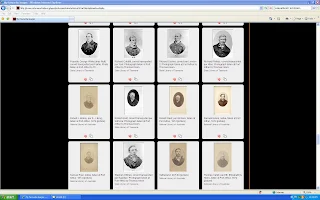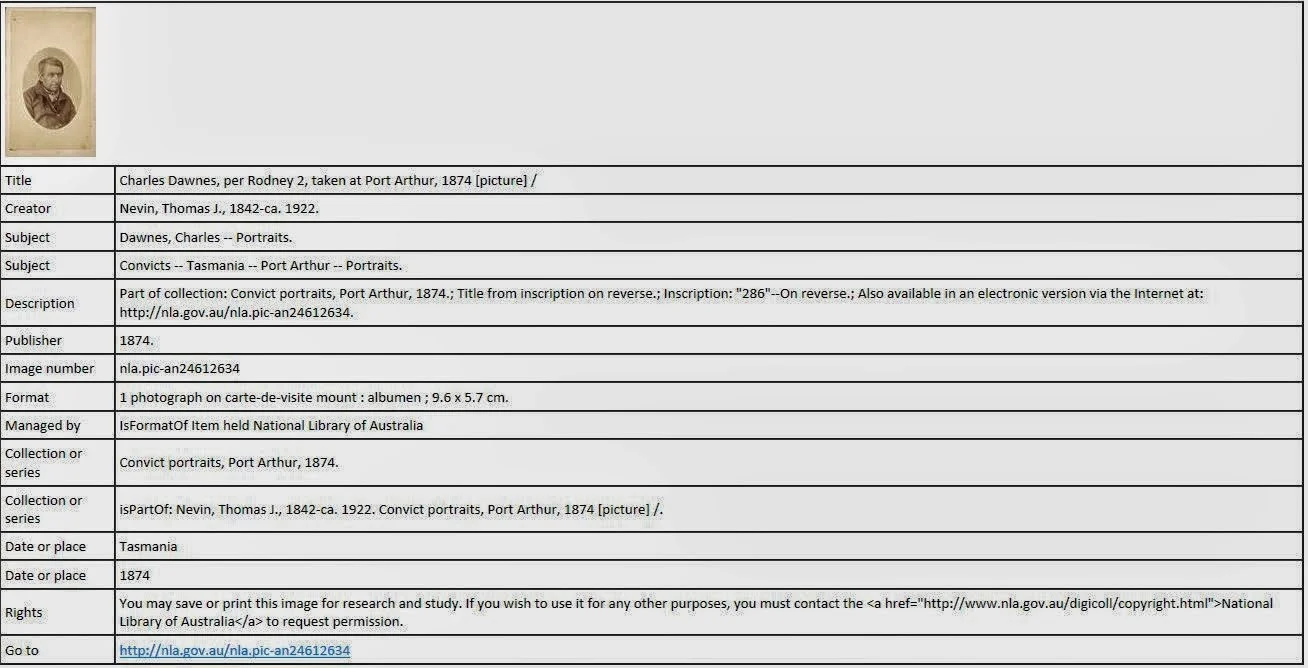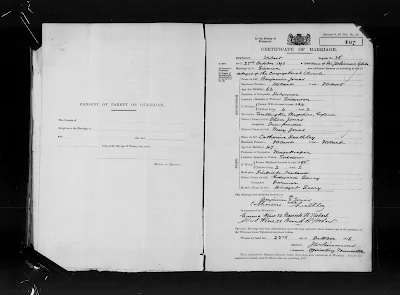The Digital Collection displays 82 images (of 84) online;
The Pictorial Catalogue lists additional names and information; and
The Photographers' Files include accession details, correspondence, and worksheets.
The Picture Australia site has so far harvested 157 convict photographs from the NLA Collection and the Archives Office of Tasmania with Nevin's attribution.
PICTURE AUSTRALIA: digital harvest 8th February 2010 (NLA and AOT, 157 images)

Digital harvest from the National Library of Australia’s Picture Australia service of Thomas Nevin’s convict photographs held in public libraries: performed 8th February 2010. Webshots only.

















NATIONAL LIBRARY of AUSTRALIA CATALOGUE: collections and documents

NLA CATALOGUE at April 2007
[Header] Nevin, Thomas J., 1842-ca. 1922.
Title: Convict portraits, Port Arthur, 1874 [picture] / Thomas J. Nevin.
Date: 1874.
Extent: 78 photographs on carte-de-visite mounts : albumen, some col. ; 9.3 x 5.7 cm.
Summary: 78 identification photographs of 70 Port Arthur convicts taken at about the time the settlement was closed. All are annotated on reverse with the subject's name, the ship they were transported on, and 'Taken at Port Arthur 1874'. The photographs bear Thomas Nevin's studio stamp.
Notes: P1029/56 - 62, 64-67 from the Gunson Collection.
Twenty-two portraits were exhibited: "In a New Light: Australian Photography 1850s-1930s";

These webshots taken in May 2007 of the National Library of Australia's holdings for 78 photographs of Tasmanian prisoners taken by photographer Thomas J. Nevin between 1871-1886 show correct attribution from accession records dating from 1982. A further six photographs were digitized in 2009. The reproduction online of the 22 photographs digitized for the exhibition "In A New Light", 2000 are better in quality than the more recent digitization of the remaining 60 or so in the NLA's collection. This exhibition was the first of the NLA's misattribution of the photographs to the non-photographer A.H. Boyd, a result of pressure brought to bear on Pictorial staff by Warwick Reeder (MA thesis ANU 1995) among others who had used Chris Long's "belief" in Boyd as "new evidence" without checking any of his sources; if they had bothered, they would have discovered that he had cited statements which were never made by those whose work he cited, eg. Margaret Glover.
The NLA persists with this misattribution to A.H. Boyd under pressure from an individual called Julia Clark seeking personal advantage over any other PhD student, school student, researcher, or member of the public. The current NLA catalogue ADVERTISES her name with this entry on every convict portrait, overkill indicative of the lack of real evidence. The dead-end anomaly about A.H. Boyd was first noted on our weblogs in 2005. Clark has had five years to PROVE Boyd's attribution, which she hasn't. The wording here - "... considered more likely" is not evidence; it is evidence only of the lack of evidence. See this article on the PARASITIC ATTRIBUTION to A.H. Boyd and other articles dealing with attribution issues.
The catalogue states (as at May 2010):

[webshot]
TitleIt is futile chasing Clark's anomalous vacuities to their inevitable dead-end regardless of the NLA cataloguist's personal opinions (and the petty politics which inform them). A.H. Boyd just happened to be the man in charge at the Port Arthur prison, sixty kms from Hobart, when some glass negatives supposedly arrived as cargo destined for government stores in 1873, although evidence suggests they did not arrive. It is simplistic in the extreme to assume that the men whose photographs survive were photographed with these same glass negatives, when thousands of glass negatives and thousands of prisoner photographs were in existence in Tasmania by 1874. There is no factual connection between photography and A.H. Boyd who had no reputation in his lifetime as a photographer, no works by him are extant, and no documents exist that associate him with the Tasmanian Government's 19th century police photographic activities dating from Nevin's engagement in 1871 and the introduction of the related legislation in 1873. Boyd played no role in the creation of these police mugshots which the NLA insists on calling "Convict Portraits, Port Arthur 1874". The assumption that these men were photographed at the Port Arthur prison is fundamentally incorrect. They were photographed at the Hobart Gaol after their criminal trial in the adjoining Supreme Court. These men were recidivists and repeat offenders whose extensive criminal careers in the open prison of the island of Tasmania earned them a further sentence and a mugshot by Thomas Nevin working with police on a daily basis at the Hobart Gaol and Municipal Police Office located at the Town Hall.
Charles Hayes, per Moffat, taken at Port Arthur, 1874 [picture].
Description
No photographer name or studio stamp appears on these photographs. Formerly attributed to Thomas J. Nevin, the portraits are now considered more likely to have been taken by A.H. Boyd. See: Julia Clark. A question of attribution: Port Arthur's convict portraits in Journal of Australian Colonial History, Vol 12, 2010, p77-97.; Part of collection: Convict portraits, Port Arthur, 1874.; Title from inscription on verso.; Inscription: "75 ; Charles Hayes, per Moffat [?], taken at Port Arthur, 1874"--In ink on verso.; Condition: Some foxing.; Also available in an electronic version via the Internet at: http://nla.gov.au/nla.pic-vn4506217.
Subject
Hayes, Charles -- Portraits.
Subject
Convicts -- Tasmania -- Port Arthur -- Portraits.
Publisher1874.
Image number
nla.pic-vn4506217
Contributor Boyd, A. H. (Aldolarius Humphrey), 1829-1891..
The NLA acquired some of their collection from Dr Neil Gunson as archival estrays in the 1960s from the Sheriff's Office, Hobart Gaol and Benevolent Society (Dan Sprod papers NLA MS 2320 1.5.64 Missionary history), but most of their current holdings of Tasmanian prisoner photographs in Nevin's name were acquired ca. 1982 in an album from the QVMAG exhibition 1977, although the album was not accessioned until 1995, by which time the provenance was supposedly forgotten. The curator of the QVMAG exhibition (1977) of Nevin's prisoner photographs indicated that this album was sent first to the National Gallery of Victoria, and then forwarded to the NLA a year or so before 1984 (interview at NGA 1984). This album was still intact in 2001: the cartes were still positioned in mounts on album leaves, witnessed by a Nevin descendant.
Many of these convict cartes held at the NLA are Nevin's original duplicates of the same images held at the Queen Victoria Museum and Art Gallery, the Tasmanian Museum and Art Gallery, and the Archives Office of Tasmania. Several were copied by John Watt Beattie in the early 1900s and deposited at the TMAG. This simple fact underscores the extensive dispersal which has taken place since the mid 20th century, principally from the QVMAG collection (numbers on recto and verso): 1958, 1977, 1982, 1985, 1987 and most recently for a digital database. Although the Nevin brothers photographed more than a thousand prisoners over two decades, the bulk has been lost, destroyed or sold at private auction. The remaining 300 or so were selected or salvaged by Beattie ca. 1916 to display to tourists; he selected only those prisoners whose sentences were severe enough to warrant a criminal sitting in the Supreme Court: the offender's apparent notoriety was the selling point. In this respect, they are not a random selection, nor a series. But they were not salvaged because they were an archive held at Port Arthur; they were never held at Port Arthur, nor taken there. Nevin photographed the prisoner once as a single capture in Hobart, produced multiple prints as cartes-de-visite on oval mounts from his original glass negatives at his city studio and later at studios in the Hobart Gaol and Municipal Police Office, and made at least four duplicates from his glass negative for circulation to other prisons and police in regional Tasmania, in addition to the copies needed to paste onto warrants, prisoner records sheets, and the central register held at the Hobart Town Hall.
Whether or not Nevin's stamp or handwriting appears on the verso of these cartes held at the NLA is not important unless you want to believe the indefensible Boyd furphy. Police photography has rarely been accredited, not even when a 19th century professional and commercial photographer was involved, as in Thomas Nevin's case in Tasmania and Charles Nettleton's in Victoria. The documentation of Nevin's career is now extensive, and his photographic work, including prisoner photographs held in all other public and private collections, some of which bear his government contractor's studio stamp with the colonial warrant Royal Arms insignia (QVMAG, SLNSW), clearly attest to his employment both as a commercial photographer and civil servant under contract to the Hobart Municipal Police Office and Prisons Department for most of his working life (1864 - 1886). Nevin's colonial Royal Arms warrant studio stamp, identical to the seal of the Hobart Supreme Court, was used to register joint copyright with the Customs and Patents Office and the Hobart City Corporation (one trade sample per batch of 100), to access his commission, and renew his contracts (1868 -1876). Once he became a full-time civil servant with the HCC in 1876, the stamp was unnecessary. His brother Constable John Nevin was his assistant at the Hobart Gaol for the later years of Nevin's service to the Municipal Police Office (1876-1886).
The NLA's accession records reveal how vague the NLA has been with regard to the provenance of their collection, and the meagre attention paid to accuracy, let alone veracity. First they asserted their these photographs of Tasmanian prisoners carried Thomas J. Nevin's stamp on the versos, now they say no photographer's stamp appears on the versos, as if police photographs are to be measured by the same standards as commercial art photography. Such expectations measure only the degree of ignorance of the staff in matters of attribution.
In addition to the digitised 82 convict portraits by Thomas J. Nevin there are three more photographs in the NLA collection taken by T. J. Nevin of prisoners William Lee, William Meaghers and Charles Rosetta in the 1870s. All three are reproductions of Nevin's originals by Beattie and Searle, 1916, and have not been attributed to Nevin, although they should be, because these prisoners were well and truly dead by 1916..
The NLA has performed a batch edit on all 82 portraits currently online, with the misleading head entry "Convict portraits, Port Arthur, 1874." Not all items bear the copyist's and/or archivist's inscription on verso, "Taken at Port Arthur, 1874." The inscription probably dates to ca. 1916 when these images were copied and offered for sale to tourists by John Watt Beattie in his convictaria museum, located in Hobart; he also contributed these to the travelling exhibitions in the early 1900s on the fake convict ship Success at Sydney, Adelaide and Hobart.

Recto and verso with carte insert, NLA collection of Tasmanian prisoner photographs by T. J. Nevin.
This portrait (below) of convict Edington is an example of the NLA's poor reproduction (recto) of the 50 recently digitised since May 2007, and of incorrect information re place and date of capture. The inscription on verso merely states that John Edington was a "native" - i.e. a local, and that his two-year sentence was for robbery:

NLA Catalogue
nla.pic-vn4269866
John Edington, native, robbery 2 years, taken at Port Arthur, 1874 [picture] 1874.
1 photograph on carte-de-visite mount : albumen ; 9.4 x 5.6 cm. on mount 10.5 x 6.3 cm.

PHOTOGRAPHERS FILES

Webshot of Thomas Nevin's ephemera file containing accession sheets, work sheets, correspondence, and newspaper articles, included in the Photographers Files, held at the National Library of Australia.
PICTORIAL LISTS
Catalogue entry (2003)
Nevin, Thomas J., 1842 – ca.1922 [sic-1923]
Convict portraits, Port Arthur, 1874
Lists for Pictorial Collections

http://pandora.nla.gov.au/pan/21336/20031011-0000/www.nla.gov.au/pict/list/nevin.html

Accession Nos.: P1029/1-55 AN11590418
* Indicates portraits also held in Archives Office of Tasmania
Accession number: convict's name:
P1029/1 William Adams
P1029/2 William Baker*
P1029/3 George Brown
P1029/4 James Calhaun
P1029/5 James Conlaw
P1029/6 Charles Dawnes* [sic -Downes]
P1029/7 Dennis Dogherty
P1029/8 John Doran
P1029/9 John Edington
P1029/10 George Fisher
P1029/11 John Fitzpatrick
P1029/12 James Foley*
P1029/13 William Forster*
P1029/14 Thomas Francis
P1029/15 John Funt
P1029/16 James Gearey [sic - Geary]
P1029/17a Michael Gilmore
P1029/17b Michael Gilmore
P1029/18 Michael Gilmore
P1029/19 Francis Gregson
P1029/20a John Gregson
P1029/20b John Gregson
P1029/21 Thomas Griffin
P1029/22 George Grawsett (missing) [sic Growsett]
P1029/23 James Harper
P1029/24 William Harrison*
P1029/25 William Hall
P1029/26a Walter Johnson
P1029/26b Walter Johnson
P1029/27a James Jones
P1029/27b James Jones
P1029/28 John Jones
P1029/29 Peter Killern [sic - Killeen]
P1029/30 Thomas Kelly*
P1029/31 Duncan McDonald
P1029/32 Luke Marshall
P1029/33 John Merchant*
P1029/34a Thomas Molineaux
P1029/34b Thomas Molineaux
P1029/35 John Moran
P1029/36 John F. Morris
P1029/37 William Mumford
P1029/38a John Murphy
P1029/38b John Murphy
P1029/39 Henry Page*
P1029/40 William Price
P1029/41 Thomas Reilly
P1029/42 Henry Singleton*
P1029/43 Sutherland
P1029/44 John Toomey
P1029/45 William Walker*
P1029/46 Charles Ward
P1029/47 John White
P1029/48 Henry Williams
P1029/49 John Williams (missing card and original pic)
P1029/50 George Wilson
P1029/51 John Appleby
P1029/52 Ephraim Booth
P1029/53 William Cambell [sic - Campbell aka Job Smith]
P1029/54 William Woodley
P1029/55 James Wynn
Gunson collection accession nos: P1029/ 56-62
Accession Nos: Convict’s Name:
P1029/56 Thomas Cahill
P1029/57 Samuel Evans (No neg)
P1029/58 John Finlay [or Finelly(sic)]
P1029/59 George Johnson
P1029/60 John Morrison
P1029/61 James Thomas
P1029/62 William Yeomans
P1029/63 Johns Williams
See detailed records of these prisoners here Prisoner Pictures.
NLA CATALOGUE 2005.
RELATED POSTS main weblog

























